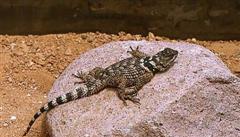Spiny Lizard - Crevice
Scientific Name: Sceloporus poinsettii
Thu, 10th July, 2025 - 12:52 am GMT
Sponsor Ads:

Alternative Name
Scientific Name: Sceloporus poinsettiiBasic Info
Crevice Spiny Lizards generally grow to lengths between 5 and 11.5 inches. Their necks feature dark collars bordered by lighter coloration, while the predominant color of the Crevice Spiny is reddish to greenish gray shade. Usually, their long tails are banded. Females and immature lizards usually have darker stripes crossing their backs, and some have slender mid-dorsal lines. Males do not have these dorsal stripes, but rather have blue patches on their throats and on either side of their bellies. The large scales of Crevice Spiny Lizards give the animals their names, since they appear to be spiny. The scales of Crevice Spiny Lizards often have a much rougher appearance than those of other lizards of their genus.
Health
In captivity, Crevice Spiny Lizards can do well when kept in a terrarium with a sandy substrate. They should be provided with patches of moist peat moss or a humidity box to allow them pockets of humid air. Crevice Spiny Lizards usually enjoy lots of hiding areas or branches. Flat rocks may also be appreciated. A basking spot of about 100 degrees Fahrenheit should be provided, and the overall ambient temperature should remain around 85 degrees Fahrenheit. At night, the temperature can drop down to about 70 degrees Fahrenheit. Crevice Spiny Lizards often eat crickets, spiders, flies, or moths. Many people also offer their lizards pinkie mice, superworms, or waxworms. Water can be provided through a misting of the sides of the tank, until droplets form. Breeding Crevice Spiny Lizards bear live young. Usually, about 11 little lizards will be born between the months of June and July.Habitat
Found in the northern states.Behavior
In many dry North American canyons, the sight of a strongly banded tail emerging from a tiny crevice often means that a Crevice Spiny Lizard is resident to the area! These beautiful lizards are found in a limited area of North America, where they provide a natural means of insect control. Found in arid or semi-arid regions, Crevice Spiny Lizards usually retreat into a small crevice when frightened. They are often seen in dry canyons, on rocky ledges, or sunning themselves on large rocks. When they are not basking, this lizard can often be identified by a glimpse of their tail hanging out from a crack in a rock.Active during the day, Crevice Spiny Lizards are surprisingly quick and agile.Origin
North AmericaHistory
Native to North America, Crevice Spiny Lizards can be found in New Mexico and Texas in the United States. In Mexico, they are found in the northern states.Common Foods
Crevice Spiny Lizards feed predominantly on insects, although some will eat young vegetation as well.Sponsor Ads:
"Why was God able to create the universe in only seven days? Because he didn't have an installed base to deal with."
Spiny Lizard - Crevice
Coded by: BGID® | ALL RIGHTS RESERVED Copyright © 2000-2025
Disclaimer | Privacy | Report Errors / Contact | Credits









